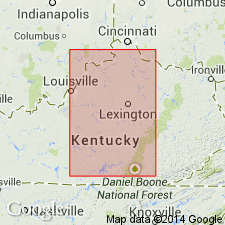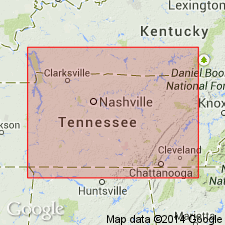
- Usage in publication:
-
- Eulie shale
- Modifications:
-
- Named
- Dominant lithology:
-
- Shale
- AAPG geologic province:
-
- Cincinnati arch
Summary:
Name Eulie shale applied at Bransford to soft argillaceous shale in three gray, yellowish, or greenish layers within the Chattanooga shale. Top layer at this locality consists of nodules. It is a single layer of greenish shale with nodules at the base at Westmoreland. Thickness 6 to 9 in. Overlies Gassaway shale (new); underlies Westmoreland shale (new). The Eulie and Westmoreland are complementary in their stratigraphic relations. The absence of either would make determination of the status of the other difficult. Age assigned is Early Mississippian.
Source: GNU records (USGS DDS-6; Reston GNULEX).

- Usage in publication:
-
- Eulie
- Modifications:
-
- Not used
- AAPG geologic province:
-
- Cincinnati arch
Summary:
Campbell considered his Eulie shale to be of Early Mississippian age, but present author classifies this gray to greenish-gray mudstone with phosphatic nodules as very late Devonian. Name Eulie shale is not used in present report. Beds named Eulie by Campbell are placed in Maury formation and not named.
Source: GNU records (USGS DDS-6; Reston GNULEX).
For more information, please contact Nancy Stamm, Geologic Names Committee Secretary.
Asterisk (*) indicates published by U.S. Geological Survey authors.
"No current usage" (†) implies that a name has been abandoned or has fallen into disuse. Former usage and, if known, replacement name given in parentheses ( ).
Slash (/) indicates name conflicts with nomenclatural guidelines (CSN, 1933; ACSN, 1961, 1970; NACSN, 1983, 2005, 2021). May be explained within brackets ([ ]).

